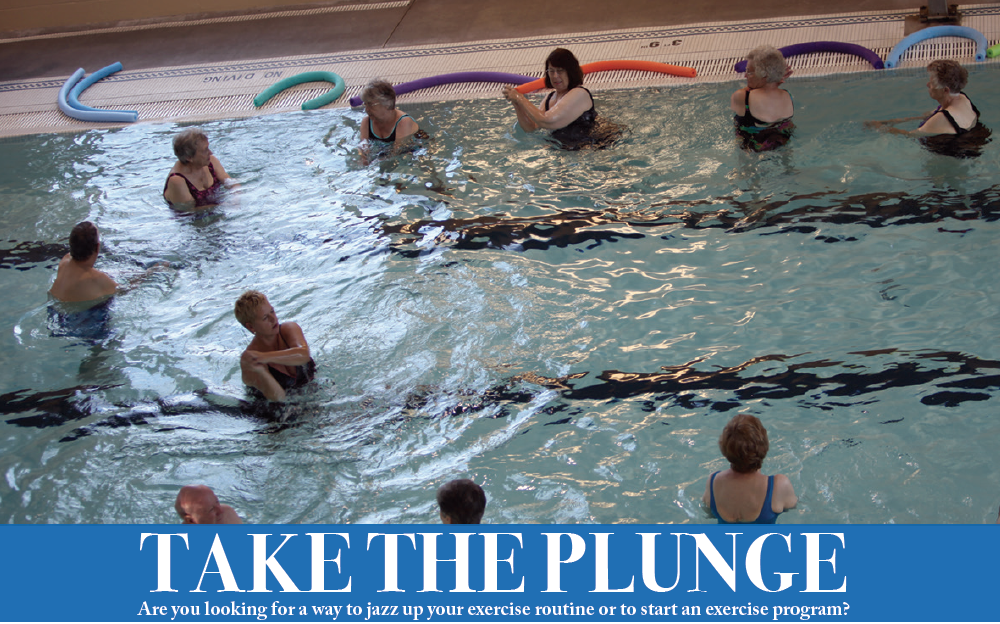| 2018 Q2 | story by Becky McClure, physical therapist at LMH Therapy Services | photos courtesy LMH

Are you looking for a way to jazz up your exercise routine or to start an exercise program? Whatever your age or physical condition, a water program can be tailored to your needs. You don’t need to know how to swim to exercise in water and you don’t have to put your head in the water. Pool exercise programs are done in the shallow end of a pool or in a pool that doesn’t have deep water.
Water exercise may be just what you are looking for to burn a few extra calories and take stress off your joints – while having fun. Thanks to water’s natural resistance and buoyancy, you will get an invigorating workout that’s low-impact and less painful than doing exercises on land. This makes water exercises a good choice for pregnant women and senior citizens, as well as people with arthritis or back problems, or who are recovering after musculoskeletal surgery.
Movement in the water is helpful for people with disabilities. For example, people with arthritis or physical challenges can move muscles and joints in the water without pain, injury or fear of falling. This can be empowering for people who can’t exercise on land.
After a back, knee, hip or ankle injury — or surgery — the water’s buoyancy will assist in supporting body weight. Reducing gravitational forces in the water will make it easier to stand, walk and do strength exercises while reducing pain and decreasing the risk of injury to healing structures.
Pregnant women find water to be wonderfully relaxing. The buoyancy of the water counters the heaviness and lack of balance that comes during pregnancy. Strengthening arms, legs and lower back is vital in preparing for the upcoming bending, lifting and carrying required in the care for the new little one.
Seniors will benefit psychologically and physically from water exercise. Exercise can counter the stiffening and slowing down that comes with age. It is often difficult to take long strides, jump or hop due to physical aging.
In the water, people are less fearful about falling, feel less inhibited and learn to trust their own improved reflexes. Increased confidence in water builds increased confidence on land. Seniors who exercise are more likely to go out and do things for themselves.
And if you’d like to strengthen your leg muscles, increase endurance and improve aerobic function, why not try water running? Never mind how far or fast you go, just run in the water for half the time you would run on land. You will find your legs will get stronger, your heart will work more efficiently and you won’t end up with sore knees or feet from pounding the pavement.
Because the human body is less dense than water, we can float in water. Water offers greater resistance against body movement than air, so muscles get a workout in the water. Yet there is little strain on muscles and joints because that same resistance slows down movement and reduces the effect of gravity. Muscles move, stretch and build without bearing as much weight as they would on land. And if that’s not enough to convince you to give exercising in water a try, here are some more reasons:
-
•
- Being in water is like being in an atmosphere with very little gravity. Think about scuba divers wearing weight belts to balance the buoyancy of the water. We can leap, stride and hop much farther in water than we can on land.
• < li >Motion in the water is slower than motion on the land. Think again about the scuba divers slow, graceful movements. The motions performed in water are smooth and there is less risk of sudden jolting movements that can cause muscle strain or injury.
• < li >The viscosity of the water offers greater resistance to muscle movement than air. The water is resisting the forward motion of the body. Overcoming this resistance builds strength and endurance while minimizing strains to the muscle.
• < li >The water’s hydrostatic pressure decreases swelling in joints that often results after an injury or with many arthritic disorders.
< li >The water pressure also improves joint position and body awareness. The hydrostatic water pressure actually is pushing down on your body producing forces perpendicular to the body’s surface. This pressure provides positional awareness to better sense where a foot or hand is while in the water.
• < li >The warmth of the water can be relaxing. Exercising in warm water, about 87 degrees, relaxes muscles, increases blood flow and reduces overall stiffness.
And just a final bit of caution: Some folks are not candidates for water exercise, including people with open wounds or with bowel/bladder incontinence. And people who have heart disease should get clearance from their physician before starting water exercise.
If you’re interested in water exercise classes, check out the Lawrence Parks and Recreation schedule: www.lawrenceks.org/lprd/aquatics/fitnessclasses. Classes are held at the Lawrence Indoor Aquatic Center, 4706 Overland Drive. For more information, call 785-832-7946.
LMH provides one-on-one aquatic therapy to patients between 8 a.m. and noon, Monday through Friday, at the aquatic center. Call 785-505-2712 for more information.




